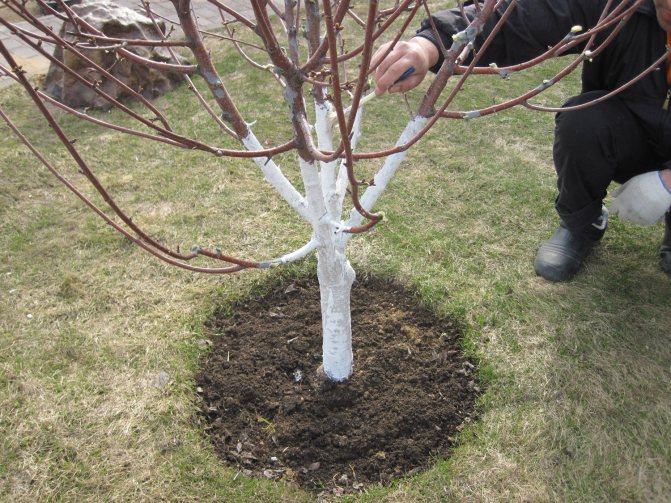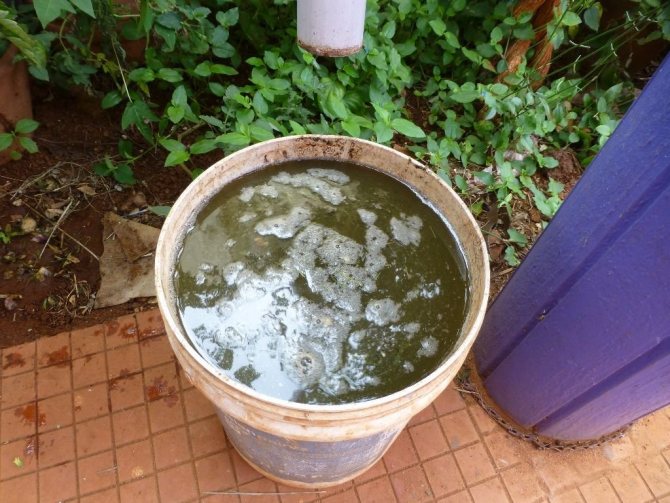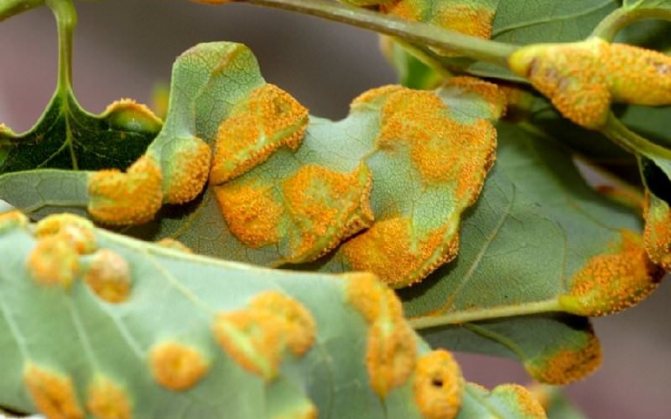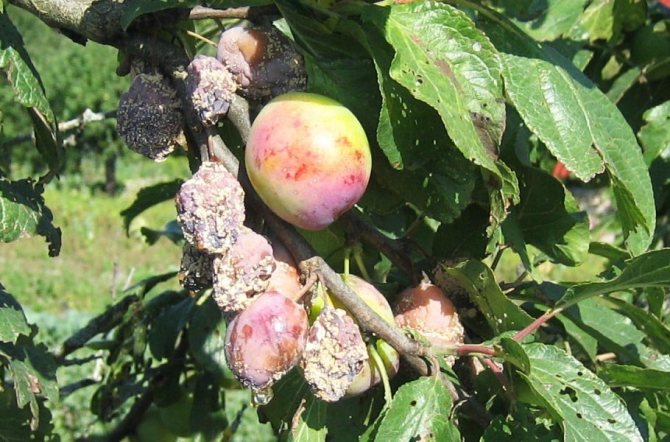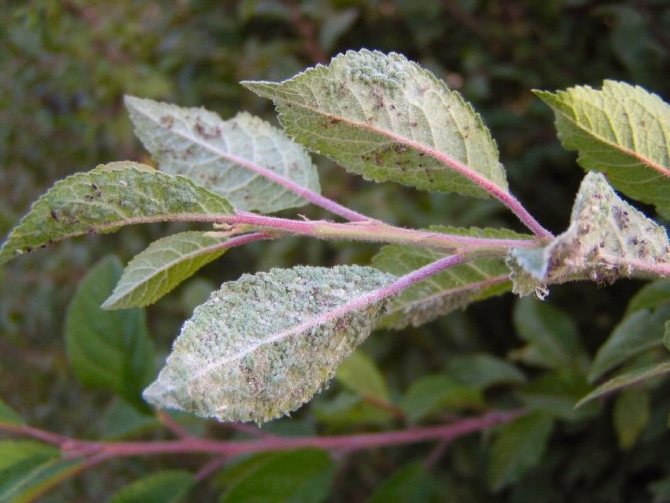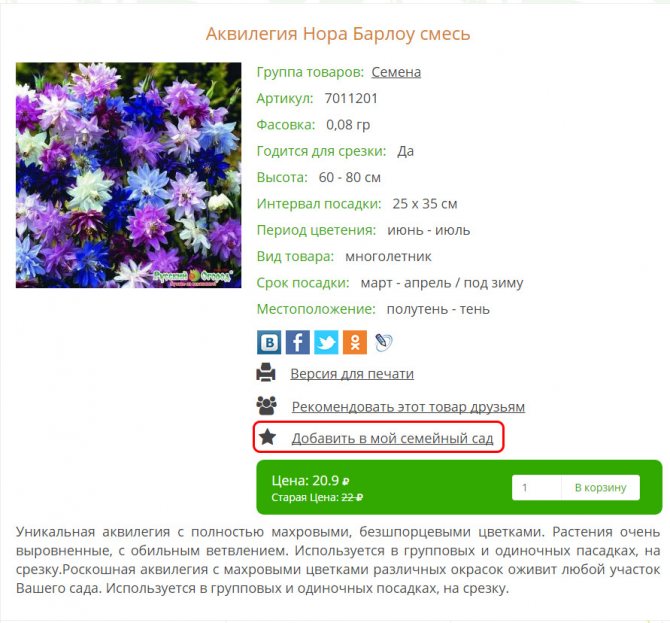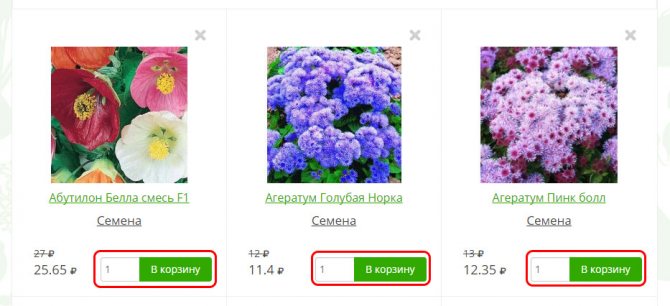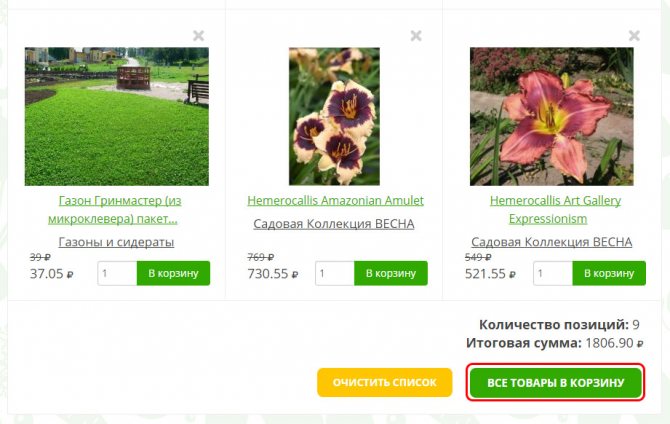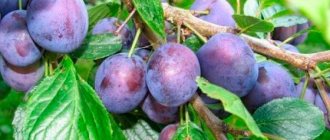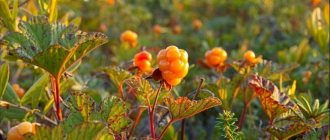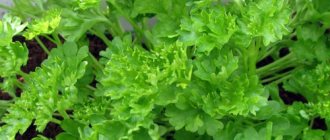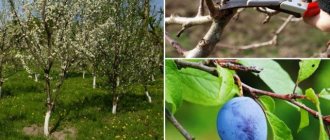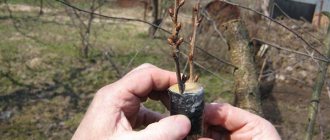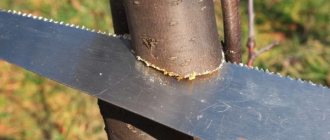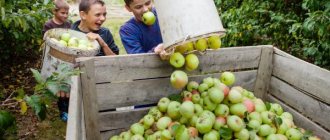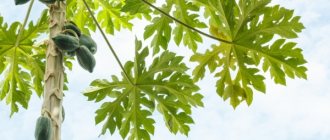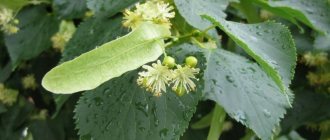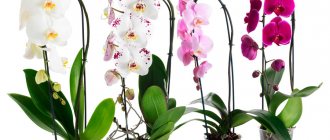The best varieties of homemade plums
The result of crossing blackthorn and cherry-plum - home plum - does not grow in the wild, as the name suggests. This variety is grown on land plots by amateur gardeners. Each year the plant bears delicious fruits rich in vitamins and minerals.
The exact history of the emergence of this type of fruit tree is unknown, but scientists have not found a plum in the wild. There is a version that this variety is the result of the work of ancient breeders, information about which has not survived to our time. Another version assumes the option of random crossing of two species.
For the first time they began to grow plums in Egypt, then in Greece. And only in the 16th century the plum was brought to France.
Description:
- home plum inherited a yellow with a red tint, the color of the pulp from cherry plum and dark blue from northern thorns;
- the height of the tree can reach 15 m in height;
- branches on the tree are smooth, some species are covered with small thorns;
- leaves are green, pointed at the ends;
- the tree bears fruit for 2-3 years;
- plum lives up to 25 years.
The size and appearance of the fruit may also differ slightly depending on the species, some of them reach a weight of 100 g. They are eaten fresh, used for conservation, baking or drying.
Existing varieties
Below we will consider the most popular varieties of homemade plums and their brief description.
- Dasha. The variety was named after the granddaughter of the creator Vladimir Yagunov. Ripens late: the harvest ripens in the second half of September. Begins to bear fruit 3-4 years after planting. Resistant to frost and cold climates. The tree is of medium height. Fruits are oval in shape, reaching a weight of 40-50 g. The skin is pink-red with a bluish bloom. The pulp is orange, juicy, sweet and sour in taste. Well suited for mid and north lanes.
- Rossoshanskaya yellow. Fruits weighing 36 g, have a greenish-yellow color with a brownish-red dusting. The pulp is amber, juicy, sweet on the palate with a slight sourness. Used to make jams, compotes, preserves, etc., and eaten fresh. Good for preparing prunes.
- Voloshka. The tree is tall, large-fruited. The mass of one plum varies in the range of 30-50 g. The skin is dark blue with spots of green or brown color. The pulp is yellow-green, juicy, sweet and sour taste. The plum is self-fertile, has a high yield.
- Evening call, evening Bell. This variety of home plum blooms in May - April. An adult tree gives up to 30 kg of harvest. Fruit weight - about 30 g, color - purple-red. When overripe, there is a high risk of fruit cracking. Frost-resistant, it will feel good in the northern and mountainous regions.
- Nizhny Novgorod home plum belongs to late ripening varieties, bears fruit from 3 years of age. Plums ripen at the end of August - September. Differs in good winter hardiness and productivity. Fruits are small - 15-20 g, yellow with a pink cover. The variety is self-fertile.
- Krasnodar. Medium-sized tree, leaves are friable, concave, 2-3 cm long. Fruit, 30 by 13 mm, weighing 30 g. Fruits are sweet and sour, used both for processing and for fresh consumption. The tree blooms in April. High heat resistance, suitable for southern areas.
- Mount Royal. A tree of medium height with a spreading crown.Fruits are of medium size, weighing up to 30 g, round, dark blue with a waxy bloom. The pulp is orange-yellow, juicy, aromatic. The taste is sweet with almost imperceptible sourness. Fruiting 4-5 years after planting. The variety is winter-hardy, disease-resistant.
Growing rules
To grow a healthy, well-bearing home plum tree, you need to know the technology of planting. This will help to avoid a decrease in the amount of the crop, and reduce the risk of diseases.
What to consider before planting homemade plums:
- grade;
- landing time;
- a place.
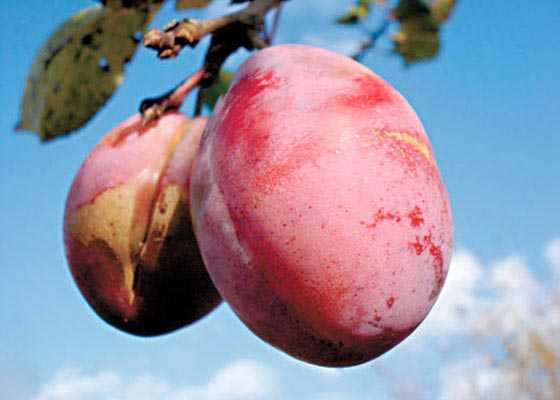
The main thing is to choose the right variety that matches the climatic conditions of the area.
Frost-resistant types of domestic plum will grow poorly in southern climates, and plums that are unstable to cold can freeze after the first winter.
Climatic conditions also affect the planting time of the plum. In the southern region, trees are planted in autumn, in the middle lane - in autumn and spring. In the cold corners of the country, homemade plums are planted in the spring, because when planted in autumn, the tree may not have time to take root before the onset of winter.
The planting site should be at least 2.5 m above the groundwater level. It is best if it is on the sunny side of the yard, because the home plum is a very light-loving plant. With a lack of sunlight, branches that are in the shade will bear fruit poorly, and are more likely to be exposed to pests.
Domestic plum is a tree about 10-12 meters high with greenish-white flowers and fruits of various shapes (ovoid, oblong, rounded). The bone is most often easily separated from the pulp.
The most interesting thing is that the species is not known in the wild. And one can only guess from which species the home plum originated. There are many varieties of the so-called folk selection, which have long been cultivated in the gardens of the middle zone (up to 57 degrees north latitude) and further south.
Of course, over the past decades, many different varieties of home plums have been bred, including hybrid ones. IV Michurin made a great contribution to the development of hybrid varieties.
One of the most common types of fruit trees is home plum. It combines 30 varieties. Representatives differ in characteristics of fruits and zoning. The varieties have gained popularity due to their versatility in use and their relatively high resistance to fungal diseases. The only drawback is low immunity to pest infestation.
Home plum - a popular tree among gardeners
The variety is common in the temperate zones of the north and south. It enters the flowering phase in April-May, depending on the region and weather conditions. The culture is demanding on soil moisture. This is due to the shallow bedding of the rhizome.
Depending on the variety, the life cycle is 15-60 years. It enters the fruiting phase in 3-7 years from the moment of planting in open ground. Plums grown from a stone come into fruiting later than grafted seedlings bought in a nursery.
The tree grows up to 6-8 m. The shape of the crown can be changed at your discretion. Flower buds are formed on shortened bouquet-type shoots and spurs, less often on last year's shoots. 2-3 flowers appear from one bud.
Home plum is distinguished by a long dormant period, therefore, less than other stone fruits, it is susceptible to the influence of recurrent frosts. The tree loves unshaded areas. With insufficient light, it starts to hurt.
Fertile chernozems, loess-like and chestnut soils are suitable for home plums.
Homemade plum benefits:
- low susceptibility to return frost;
- variety of varieties;
- consistently high yield from 3-7 years;
- products with high taste and a high content of nutrients necessary for the full functioning of the human body;
- versatility of fruit use;
- good resistance to fungal diseases.
Disadvantages of homemade plums:
- high demands on the quality and moisture of the soil;
- large size of the tree;
- freezing of roots located close to the soil surface in winters with little snow.
Plums are delicious and healthy
Existing varieties
The category of home plums includes a huge number of varieties. Opens a list of popular varieties of Dasha. The main quality characteristics meet all the requirements of the central strip and northern regions. Description of home plum Dasha:
- medium-sized plant with a pyramidal crown;
- flower buds are frost resistant;
- mass ripening of fruits begins in September;
- high quality fruits tolerate transportation well;
- ripe oval-shaped plum weighs 50 g;
- the fibrous sweet flesh is covered with a thin skin.
Domestic plum Rossoshanskaya large-fruited is notable for its low growth - up to 3 m. Crohn resembles a haystack, rare shoots are widely spread. The leaf blades are rounded. 2 flowers are formed from flower buds. A ripe plum weighs 40 g. The skin is green-yellow on the shaded side, purple-pink on the light side. The pulp is dense, juicy, sweet with a slight sourness.
The result of crossing blackthorn and cherry-plum - home plum - does not grow in the wild, as the name suggests.
Read next: How to feed little rabbits: diet
This variety is grown on land plots by amateur gardeners.
Each year the plant bears delicious fruits rich in vitamins and minerals.
One of the most common types of fruit trees is home plum. It combines 30 varieties. Representatives differ in characteristics of fruits and zoning.
The varieties have gained popularity due to their versatility in use and their relatively high resistance to fungal diseases.
The only drawback is low immunity to pest infestation.
conclusions
Plum Dashenka is an excellent variety for the central and northern regions, which summer residents and gardeners speak positively about. In the reviews, they share that the plant, unlike other species, is extremely livable and tolerates moisture and frost well, which other plum trees cannot boast of.
This variety is suitable for experienced and novice gardeners. It is not difficult to plant and care for the plum, the main thing is not to forget about mulching, proper watering and preventive measures.
Growing different varieties of homemade plums
Good health and rich harvests, dear gardeners! I hasten to share new information that will be especially useful for residents of northern climatic zones. Recently I spoke on Skype with a friend who recently renewed the planting of fruit trees at the dacha.
She is delighted with one acquisition, a seedling that suffered severe winter frosts in the first year. And a year later he brought the first harvest. So, welcome: Dashenka plum, description of the variety and everything related to the features of its cultivation.
Northern beauty
Dasha's homeland is the Suzdal varietal plot, therefore the main qualities of the seedlings meet the needs of gardeners in the middle lane. We, the inhabitants of the southern regions, cannot understand the problems of the owners from the Urals and Siberia. Needless to say, they have little choice: rare varieties of trees can withstand the harsh winter.
So the description of Dasha, which I met on thematic sites, captivates with its brevity. And the reviews of summer residents are the most flattering.
The characteristic of the variety is reduced to listing the advantages:
- Increased resistance of flower buds to frost, good winter hardiness of the tree as a whole;
- Excellent fruit quality and good transportability. Ripe plums reach 50 g, have an oval shape, tender, fibrous orange pulp with a detachable stone, thin peel;
- Features of fruiting - the period of mass ripening falls on September, which is important for areas with a short summer;
- Unripe fruits hibernate well, retain their taste and presentation until winter.
All varieties have their drawbacks. Dasha did not escape them either.
- The self-fertility of the plum is a big question. In other words, it is recommended to grow pollinators to increase yields in the garden;
- Growing conditions are about the same. As with all related trees. Planting and leaving are reduced to the usual manipulations. But, since the plum is medium-sized and prone to increased overgrowth formation, special attention is paid to pruning.
- At first glance, diseases bypass young trees. Despite the thin, vulnerable skin, the fruit rarely spoils on trees. But from the invasion of insect pests, they are as defenseless as the rest of the fruit.
In addition to the stories of a friend, there is very little information about Dasha. The variety is not widespread, not in demand in the southern regions. But for the conditions of the northern climate, it can be a real find.
What do you think, dear like-minded people? Did you have to grow seedlings on your site? What is the opinion of the “newbies”? Write in the comments, put "classes" in social networks. Your experience will help someone avoid mistakes.
I say goodbye to this, until we meet again!
Northern beauty
The Dasha plum variety is excellent for growing in the harsh climatic conditions of Siberia and the Urals; the variety is also famous for its unpretentious care and high yield rates. The characteristic features of the plant, its advantages and disadvantages, as well as the basic rules for growing are described below.


The variety belongs to varieties of late ripening, which falls in mid-September. The plum variety Dashenka is a medium-sized tree, reaching a height of 3 m.
The crown of the plant is pyramidal, with an average density of leaves. The bark is gray, the shoots are arched, dark brown.
Leaf plates are inversely ovoid, with smooth edges, green in color.
Important! This variety belongs to fruit crops with partial self-fertility, therefore, pollinators must be planted near the tree.
Fruits on thin petioles, rounded. The color of the fruit is dark blue, with a waxy coating. The mass of one fruit can reach 50 g.
The skin is thin, dense in structure. The soft part is tender and contains fibers. The taste is sugary sweet.
The stone is medium in size, with difficulty separating from the pulp.
Chemical composition
Chemical composition per 100 g of product and calorie content:
- proteins - 8 g;
- fats - 3 g;
- carbohydrates - 9.6 g;
- dietary fiber - 1.5 g;
- water - 86.3 g;
- starch - 0.1 g;
- ash - 0.5 g;
- calorie content - 49 kcal.
The product is rich in minerals and vitamins that are involved in the body's metabolic process and protect the immune system from viral infections. Magnesium, potassium and calcium - participate in the formation of bone tissue, strengthen the nervous system.
Phosphorus, sulfur and chlorine - stimulate metabolic processes in the body and increase brain activity.
Iron and zinc - strengthens the nail plates and prevents hair loss.
Vitamins of group B and C help to strengthen the immune system and prevent insomnia. Vitamin E strengthens the walls of blood vessels.
- Advantages of the variety:
- The early maturity of the variety. The tree begins to bear fruit in the 3rd year of growth.
- Frost resistance up to -34 ° С.
- The versatility of the use of fruits in the food industry.
- Resistant to aphid infestation.
- Resistance of flower ovaries to frost up to -3 ° С.
- Medium resistance to infection with fungal diseases.
- Long-term freshness of fruits.
- Good transportability.
Among the shortcomings, one can single out the exactingness of the culture to the composition of the soil - it is unacceptable to plant a plum on acidic soil.There is a risk of freezing of the rhizome, which is located close to the soil surface, in winters with little snow.
To grow a healthy and strong plum tree, you must follow the rules for planting it in open ground.
In order to avoid problems with cultivation, you must take care of the correct choice of a place for planting, which should be:
- on a hill or flat surface;
- with a groundwater level of at least 1.5 m;
- well lit;
- no drafts.
Boarding time
Planting a seedling in open ground is best done in spring, in mid-April, when the air warms up to 17 ° C.
Important! Seedlings planted in spring are easier to tolerate in winter.
Soil preparation
Soil preparation should be carried out in advance, because the plum should grow on well-fertilized, neutral soil.
In order for the culture to develop well, you first need to make sure that the soil in the selected area is not acidic.
This procedure can be carried out using a litmus test purchased from a specialized store.
Litmus paper for acidity determination
For the test, you will need to collect soil from several areas of the selected location and place the samples in rag bags.
Each specimen is placed in a glass with distilled water for 5 minutes, after which the litmus test is immersed in a container for 30 seconds and the result is checked against the scale attached to the test.
The measurement scale starts at 0 and ends at 14 - the lower the value, the more acidic the soil, and the higher, the more alkali it contains. An average value of 7-8 indicates pH neutrality.
To eliminate the acidic environment of the soil, it is necessary to add dolomite flour there, which is scattered over the soil surface.
With increased acidity with a pH value of 0–3, it is necessary to apply 600 g per 1 m², slightly acidic soil with a value of 3-4 requires 400 g per 1 m², light soils require an application of 200 g per 1 m².
The preparation of the planting pit is also carried out in the fall, in October. Dig a hole 70 cm deep and 80 cm wide.
The first layer of earth dug out of the hole is fertile, it is poured next to the hole in a separate slide.
The prepared hole is covered by a third with a mixture of the top layer of soil, peat and humus, mixed in equal amounts. The resulting mixture is added 300 g of superphosphate and 600 g of wood ash.
Important! Acidity must be eliminated in the fall in order to plant seedlings in neutral soil in the spring.
With the onset of the spring thaw, the seedlings are planted in the soil. In a specialized store, two-year-old seedlings are chosen that have a trace of grafting.
The plant should be 1 m tall, with a well-developed rhizome. It is necessary to plant the plant only after careful examination for damage to the root system.
Read more: Pergolas in the garden. How to make a wood pergola with your own hands - arch for grapes and climbing plants
Rotten and broken roots are carefully cut with a knife.
Plum planting:
- A peg is driven into a hole prepared in the fall so that it is 50 cm above the level of the hole.
- A seedling is introduced into the pit, straightening the roots.
- The soil is poured to the top, tamping tightly.
- Tie the plant to a peg.
- Water the seedling with 10 liters of water.
Landing scheme
The plum variety Dashenka is medium-sized, so the seedlings are placed according to the scheme - 3-4 m between trees and 2.5-3 m between rows.
A young tree especially needs care, because further growth and development will depend on its correctness and timeliness.
Crown pruning
Pruning the crown of a young tree is carried out starting from planting. It is necessary to shorten the main shoot by a third.
In the second year of growth, shaping pruning is also carried out, in which all shoots are completely cut off, except for 4-5 main ones.
For the next 2 years, it is necessary to remove branches from the main shoots, which do not grow at an acute angle.
a - seedling; b - the second year; c - the third year; d - the fourth year.
Watering plums should be regular, especially in the first 3 years of life, when the plant needs moisture.
Watering is carried out in the near-stem circle, in the amount of 20 liters of water 2 times a week.
The liquid should be kept warm for 2 days.
Pollinating varieties for pears Dasha:
- Peaceful;
- Ternoslum Kuibyshevskaya;
- Early ripening red.
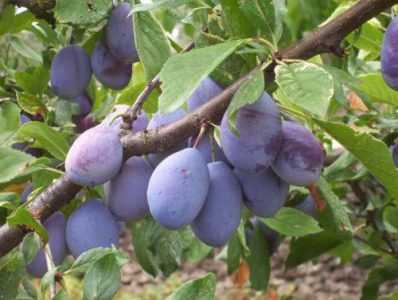

During the first 2 years of growth, the crop does not need additional fertilization.
Subsequent dressings are applied by alternating organic and mineral fertilizers.
Before flowering, at 3 years of age, it is necessary to apply nitrogen fertilizer, which is prepared from chicken manure - 2.5 kg per 10 liters of water.
In the summer, organic matter is also introduced - 2 kg of mullein per 10 liters of water.
In the fourth year of growth, trees that have begun to bear fruit need top dressing of 60 g of urea, 60 g of potassium sulfate and 10 liters of water.
During the ripening of the fruit, a solution of 60 g of urea and 90 g of nitrophoska per 10 liters of water is added. At the end of the harvest, fertilizing is made from 60 g of potassium sulfate and 90 g of superphosphate, diluted in 10 liters of water.
Mineral solutions are applied in an amount of 30 liters per adult tree.
Plum trees need shelter for the winter, especially if the growing region is famous for severe frosts and the tree has not reached 3 years of age.
Diseases and pests
If the fruits, trunk or leaves of a tree have changed their appearance, this may indicate the development of diseases or the appearance of pests.
- Clasterosporium disease is also called perforated spot. Belongs to a class of fungal diseases that affect the buds, branches and flowers of a plant. It is accompanied by the following signs: crumbling holes on the leaves, brown in color, foliage is prone to rapid drying and premature abscission, shoots also become covered with brown spots and crack over time, buds die off. This disease worsens the condition of the tree and reduces yields. You can fight it with 1% Bordeaux liquid, you need to spray it over the infected surface. One young tree takes 2 liters of solution, for an adult - 10.
- Moniliosis. It manifests itself on a home plum in the form of growths on the bark, as a result, the trees turn brown and wither. Outwardly, it is very similar to a burn. For treatment, 3% Bordeaux liquid is used during the budding period and 1% before flowering, after which it is also treated with a 1% solution. The dosages are the same as for the fight against clasterosporium disease. Affected fruits, leaves and branches can be harmful to other healthy trees and should be cut off and burned.
- Root cancer. Occurs when the root is damaged and bacteria are present in the soil. It is accompanied by a lack of plant growth and the death of seedlings. Slightly alkaline and neutral soils are at risk during drought periods. The seedling can be saved by digging up and removing the growths, disinfecting with copper sulfate. If there are too many growths, the seedling needs to be burned. After the procedure, garden tools that have interacted with a diseased tree are treated with 0.5% chloramine solution or formalin.
- Garden aphid. Appears on young shoots. The leaves turn yellow and fall off prematurely, and the trunk itself begins to curl. Spraying with Novaktions in the amount of 800-1200 l / ha helps to fight the pest. Repeat the procedure 4 times. The active action lasts for 1-2 weeks.
- Gum flow appears in frozen trees affected by a fungus, with too high soil moisture and an excessive amount of fertilizers. Due to the disease, gum is released from the trunk and branches. A solution of copper sulfate or garden variety will help to overcome the ailment. If the lesion is too severe, the branch is removed.
Preventive measures
Prevention of diseases and pests of domestic plum is carried out in the spring, mainly at the moment when the sap begins to move in the plant - at the end of March.For this, 10 liters of water and 700 g of urea are used. If the buds have blossomed, and the treatment has not been carried out, the drug "Agravertin" will do. 5 l of the product is diluted in water. After 6-10 hours, the pests stop feeding, and after 3 days they die. Effective against ticks, aphids and leafworms.
Hybrid plums Michurin
Kolkhoz renklode
IV Michurin bred 13 varieties of valuable hybrid plums using the method of selection, interspecific and intergeneric hybridization. They are distinguished by good frost resistance, high taste and immunity to gum flow. Here is some of them.
- Transparent yellow - a hybrid of plum with apricot.
- Golden rennlode, collective farm rennlode, thorny rennlode are hybrids of thorny plums with green rennlodes.
- Dessert and sweet blackthorns are obtained by pollination of blackthorns with pollen of green grass.
Michurinsky plums were later used to develop new varieties. And in many garden plots in Russia, varieties created by Michurin grow.
Ternos (Prunus insititia)
Blackthorn
Blackthorn is a thorny shrub, sometimes a tree up to 4-5 m high. Its leaves are serrate, about 2-4 cm long, slightly fluffy at the edges or bare, and fluffy at the beginning of blooming. Fruits are tart in taste, spherical 1-1.5 cm, blue-black with a bluish bloom. The growth rate is low. Relatively thermophilic, demanding on the soil. Very good for creating dense and dense thorny hedges.
The homeland of the blackthorn is the southern and middle zones of the former USSR, the south of Western Siberia, the Caucasus, Crimea. Can grow and bloom well in gardens up to Moscow and the Leningrad region.
The blackthorn has decorative forms:
- terry - long and profusely blooming with white double flowers;
- purple - with pink flowers, less prickly, and purple leaves larger than the typical form.
Terry and purple turns are good in groups.
Ternoslum
Ternosplum is a shrub or tree up to 6 m tall. Leaves 4-8 cm long, crenate-serrate at the edges. White or greenish flowers, fruit 1.5-1.8 cm, black with a bluish bloom, stone with sharp edges, does not separate from the pulp.
In culture, they knew thorny since ancient times (in Western Asia and Europe), in some places it has run wild and is often found in the mountains of the Caucasus.
Care
Plum is a tree that needs a well-lit place and timely watering. If it is carried out irregularly, then the fruits will crack. During the growing season, the soil is moistened 3 to 5 times, depending on weather conditions. One watering assumes a consumption of 4-6 liters of water for a young tree and 10 liters for a fruiting one. In the fall, be sure to carry out preparatory watering for winter.
In the first 4 years, the shoots are pinched with a length of 30-40 cm. They are fed with urea or ammonium nitrate in the amount of 20 g per 1 m2. In June, fertilizer is applied to the ring furrows around the tree using organic fertilizing. Then the soil is mulched.
In the autumn period, manure or compost is added to the soil in a volume of 3 kg per 1 m2. A non-fertile tree in the fall does not need to be fertilized, but should be fed next summer.
The best varieties of homemade plums
Plum varieties can be divided into 3 groups depending on the ripening period: early, mid-ripening and late. And in each of these groups there are the best representatives who are distinguished by their unpretentiousness.
We have already written about the best early ripening plums in the article Early varieties of plums - the sweetest and most aromatic.
Blue gift
This mid-season hybrid variety (the tree bears fruit in the second half of August) is self-fertile. However, he has a rather low yield - up to 15 kg per tree. But if you are not going to make numerous blanks from plums or sell fresh fruits, then this medium-sized tree with an oval crown should be planted on your site.
Plum buds Blue Dar safely tolerate return frosts in spring - and this is the main plus of the variety.The oval fruits of this plant, although small (weighing up to 20 g), are quite sweet, the stone separates well from the dense greenish-yellow pulp. The skin is dark purple with an abundant waxy bloom. The purpose of the fruit is universal.
Souvenir of the East
In mid-August, this medium-sized tree with a spreading crown ripens a large number of large fruits (weighing about 40 g), round in shape with a pronounced side seam. The skin is orange to maroon. Dense, juicy, aromatic, sweet-spicy yellow-orange pulp of the fruit tastes like a peach.
The yield from one adult tree is 25-40 kg of ripe fruits. However, of the minuses of this variety, it is worth noting the defeat of the leaves by clasterosporium.
Hungarian
This is not the name of a specific variety, but a varietal group of popular homemade plums. It includes Hungarian Italian, Belarusian, Moscow, Azhanskaya, ordinary, Wangenheim and others. Rather large oval fruits ripen on these trees in August. They have a dark purple rind with a bluish bloom. The pulp is juicy, soft, sweet and sour, greenish.
Prunes are prepared from the fruits of this particular variety, since they contain a sufficient amount of sugar and pectin, which makes it possible to obtain a delicious dried product.
This late variety of American home-bred plum was bred back in 1912, but has not lost its popularity to this day. He also belongs to the Vengerka group.
Stanley plum withstands frosts down to -34 ° С, annually (starting from the age of 4-5 years) it gives a high yield (up to 60 kg per tree), however, the fruits may suffer from moniliosis. In addition, trees are demanding on soil fertility and are susceptible to attacks by plum aphids.
But the above difficulties do not frighten gardeners, because this variety is distinguished by large fruits (weighing 35-50 g) obovate, ripening in early September. The skin is of medium thickness, dark purple with a waxy bloom. The pulp is grainy-fibrous, yellow, aromatic, sweet (with a slight sourness).
Stanley is a partially self-fertile variety. To get a rich harvest, it is recommended to plant nearby plums of the varieties Bluefri, Empress, Chachakskaya Lepotika or Chachakskaya the best.
The president
Another old late variety. It was bred in Great Britain in the 19th century. The tree grows rapidly and reaches a height of 3 m. Fruiting at the end of September. Fruits are large (weighing 45-70 g), round in shape. The skin is of medium thickness, burgundy-blue in color. The pulp is greenish-yellow, juicy, sour-sweet.
The tree bears fruit annually, but the first harvest gives only 5-6 years of life. Ripe fruits do not fall off the plant for a long time.
The tree tolerates dry summers and frosty winters well, is resistant to fungal diseases, but it can be damaged by plum aphids. The variety is considered self-fertile, however, in order to increase the yield, it is recommended to plant plums of the varieties Mirnaya, Skorospelka krasnaya, Stanley, Renklod Altana, Ternosliv Kuibyshevskaya in the garden.
If the summer turns out to be cool, in the suburbs of the Moscow region, the plums of the President variety do not have time to fully ripen. The fruits become sour, but they are good processed.
Read more: What year does the plum bear fruit after planting
This is one of the best varieties of yellow plum. On the tree, which grows up to 5 m in height, round fruits ripen in the second half of July, weighing 35-50 g. They have a yellow skin with a white waxy bloom. The pulp is sweet, aromatic, juicy, with a honey flavor, greenish-yellow or bright yellow color. Fruiting occurs in late July - early August.
The tree tolerates severe winters, rarely gets damaged during spring return frosts, and is resistant to drought and major diseases. The variety is self-fertile, so you cannot do without pollinating varieties, the best of which are Vengerka Donetskaya and Renklod Karbysheva.
If you liked the variety presented by the latter, then you will surely like bright plums of various colors. We talked about them in the article Multi-colored plums - we choose a variety for every taste.
Plums are very rich in potassium and phosphorus
We bring to your attention the best varieties of plums that can easily take root in the northern regions of Russia.
Smolinka
The fruit is medium, dense, has a sweet and sour taste. The pulp is elastic. The berry is regular, egg-shaped without pronounced depressions, the abdominal suture is practically not noticeable. It is considered one of the best plum varieties for central Russia, so it gets along quite well in the Moscow region.
Smolinka
Early subspecies, good fruiting. Harvesting takes place in the third decade of August, and up to 23 kg can be removed from one tree. The weight of one fruit ranges from 30-40 g. Great for drying and curing. Smolinka makes a wonderful oily prune.
Features:
- tallness - over 5 meters;
- begins to bear fruit in the second year;
- with persistent frosts, it can freeze slightly, while with the onset of cold weather it quickly recovers;
- amenable to grafting;
- voluminous deciduous system, which takes up a lot of space in the garden, lends itself to pruning without harming the sap flow.
Zarechnaya early
The fruit is large, oval, dark purple in color. The weight of one plum can reach 55 g. Thanks to the unimpeded removal of the stone, the berries are easily suitable for all kinds of preservation, as well as for drying and drying.


Zarechnaya early
Distinctive features:
- frost-resistant species;
- increased productivity;
- the beginning of fruiting - the second year after planting the seedling;
- dessert, sweet and sour taste.
After 3-4 years of growth, it gives many stepchildren, which greatly weaken the plant. It is necessary to get rid of them in a timely manner, to prevent thickening of the tree and "wildness" of berries. It is recommended to carefully cut down the stepsons so as not to damage the trunk of the main tree. It is forbidden to use chemicals. They are used exclusively to combat dense thickets.
Read with this article: Active herbicides for tree destruction
Early
Another variety of fruit plant, which is distinguished by high yields and increased fruit weight. The mass of one plum reaches 45 grams, the taste is sweet with a slight sourness. Fruit ovary occurs in the second year of seedling cultivation.
Early
The tree is tall, in five years it can reach 4.5 meters.
Traveler
The best plum variety for the Urals and its regions. This is due to its high frost resistance. The fruit is large, round and incredibly tasty, has a yellow color with a purple tint. The bone is small, easy to get.
Cherry plum "Traveler"
Begins to bear fruit in the first decade of August, gives a high yield - up to 25 kg.
Blue bird
Mid-season, zoned for cultivation in a northern climate, so the middle zone of Russia is excellent for planting this crop. Medium-early subspecies, the berries of which are dark blue and quite heavy - up to 50 g.
Blue bird


The berries are oval, dense and waxy bloom. The crop can be harvested in the second decade of August. The stone separates well from the pulp, so from this culture you can either close the jam or dry, dry and pickle. The beginning of fruiting occurs in the second year. The disadvantage is an enlarged, spreading crown, which has a spherical shape.
But as for the benefits, the most significant ones include:
- despite the spreading of the crown, the internal branches do not block the light from each other, and ripening occurs evenly;
- seedlings are not afraid of frost;
- resistant to the most common diseases of fruit crops: minoliosis, polystygmosis and clotteroporosis;
- if the planting of the seedling and care were carried out at the proper level, then up to 35 kg can be removed from one tree;
- self-fertile.
And this, in turn, allows us to classify the Blue Bird as one of the best plum varieties for the Vladimir and Leningrad regions.
Often, the famous Georgian sauce Tkemali is made from these berries in Russia (in Georgia it is made exclusively from Tkemali plum-cherry plum). A very tasty addition to meat dishes, side dishes, vegetables and grilled poultry.
Features of culture
- Frost resistance. The variety perfectly tolerates low temperatures, without the need for shelter for the winter. Light frosts are practically not capable of harming the tree and buds.
- Low drought resistance. Plum “Dashenka” react to lack of moisture with early shedding of foliage and poor harvest.
- Diseases and pests. The variety is considered resistant to common fungal diseases in plums, but the crown often suffers from aphids and caterpillars.
Plum “Dashenka” has good characteristics, but it is not widespread in gardening, which contrasts somewhat strangely with the reviews of gardening practitioners, confirming the excellent qualities of this variety.
| Jan | Feb | March | Apr | May | June | July | Aug | Saint | Oct | Nov | Dec |
| Landing | |||||||||||
| Landing II | Taking care of every client! Fast, comfortable and inexpensive! In such a large assortment of all kinds of goods, it is very easy to get lost and of course you want so much! But it happens that there is no way to order everything at once. So that you do not lose your favorite products and do not waste time looking for them, we have created a convenient section for you where you can save the items you like. Now you can create your own personal "Family Garden". On the page of our new section, you have the opportunity to create lists, convenient for you, where your plans for future plantings will be stored. Sort products into lists by price, culture, pick-up time, any property you like. Did you like something but want to order it later? Create a list, save the selected items there and when the time comes, click the "all items in the cart" button. The total amount of the future order will be shown in the lower right corner. To get started, use the already created "Favorites" list, save all the positions you like to it. If you want to create a list with your own name, just click the "Add new list" button. Give it any name that will help you navigate, for example "Seeds for 2020", "My Club", "Summer Flowerbed", etc. And when the hour comes, in a few clicks order all the goods you need, for example, for your winter garden. Now looking through the detailed description of the product, you can click the "Add to My Family Garden" button, and the product you like will be saved in the folder of your choice. Easy, fast, convenient! Happy shopping! To add a product to My Family Garden, you need to go to the product page. Next, you need to follow the link Add to My Family Garden.
In the additional window that appears, select the list to which you would like to add the current product. You can select New List by giving it a name. After selecting the list, you must follow the link "Ok".
My Family Garden On the section page you can view all the products you have added, as well as the created lists.
From here you can add a product to your shopping cart, individually:
And also the whole list:
You can also remove an item from the selected list:
Or clear the entire list of products:
To completely remove the list, use the following link:
Create lists on a variety of topics. Examples of names can be very different: "My future summer flower bed", "For a summer residence", "Apple garden" and many others. Do you know exactly what you will order from fruit and berry seedlings? So name the list "Delicious", adding your favorite varieties there. And when the time is right, order the entire list in just a few steps. We have done everything to make My Family Garden as convenient and intuitive to use as possible! |
Cherry plum or spreading plum (Prunus divaricate, Prunus cerasifera)
Spreading plum or cherry plum - a tree 8 meters high or a tall shrub with thin, broadly spreading branches, equipped with thorns. Leaves 3-4 cm, white flowers. Long bloom in April-May (in the Far South - in March). Fruits are elliptical or spherical, red, pink or yellow, sometimes dark blue.
Cherry plum is a fast-growing plant, sufficiently drought-resistant and undemanding to the soil. Can grow on stony, dry, saline soil, but loves soft clay soils. It tolerates urban conditions normally. Cherry plum is durable, tolerates pruning well, and is considered an excellent rootstock for apricot, plum and peach.
Its frost resistance is much lower than that of other types of plums. Her homeland is the Caucasus, the mountains of Central Asia, the Pamirs, the western Tien Shan (700-1500 m above sea level). In gardens it can grow in the south of the European part - up to Bryansk and Michurinsk.
Cherry plum has wonderful decorative forms.
Plum Pissard
Dark purple-leaved (Pissard plum) - with dark purple large leaves, pink flowers and dark cherry fruits. It was first brought to Europe by Pissard from Iran, where it was cultivated for a very long time. The Pissard plum is good in the form of tapeworms and small groups against a background of greenery, but in large quantities it looks gloomy.
Wood - with leaves that are dark purple during the summer.
Purpusa - with dark red variegated leaves covered with brilliant pink and yellow spots.
Weeping - with branches drooping from top to bottom. It is better to plant a weeping form in the form of a tapeworm on a lawn or on the shore of a reservoir.
The basic form is good for groups, edges and hedges, which become dense and impenetrable thanks to the haircut.


